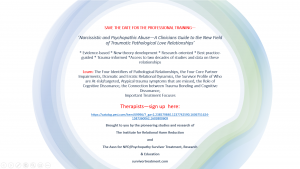Do you ever have present day experiences that trigger old, extremely distressing memories as if they were stuck in your brain? Do sights, sounds and smells that remind you of the original event leave you in an extreme state of anxiety, hypervigilance or panic? When this happens, do you hear the abuser’s ideas in your head, putting you down, criticizing or ridiculing you in some way? Do you sometimes think you are crazy? This is a normal response to traumatic material that has not been fully processed.
Eye Movement Desensitization and Reprocessing is used to disconnect emotionally disruptive memories from current life experiences. Its focus is the resolution of emotional distress arising from traumatic events. No one knows for sure how EMDR works but through brain imaging techniques, we are seeing its effects. Dr. Daniel Amen M.D., in his book, ”Healing the Hardware of the Soul”, states that, “people who have been traumatized and develop Post Traumatic Stress Disorder symptoms (such as flashbacks, nightmares, worries, quick startle response, anxiety, depression and avoidance) are frequently overly concerned and worried (anterior cingulate section of the brain-get stuck), anxious and hyper alert (basal ganglia section of the brain), and filter everything through negativity (limbic-thalmus section).” EMDR calms all of these areas of the brain according to the SPECT brain scans Dr. Amen has been doing for the last 20 years. These scans allow us to see the internal operations of different parts of the brain, allowing us to learn more about which parts do what.
When a person experiences an event that is extremely distressing and overwhelming, it is stored in the brain with all the sights, sounds, thoughts, feelings and body sensations that accompanied the event when it happened. Think of your brain as a recorder that doesn’t miss a thing, storing all aspects of an experience, whether we consciously remember it or not.
When a scary or extremely painful event happens, the brain is sometimes not able to process the experience as it normally does. The thoughts, feelings and sensations of the traumatic event can become frozen in the nervous system as if in a time warp.
EMDR helps to activate the brain’s natural processing abilities with efficiency, thereby helping to move the disturbing material through the nervous system, allowing the person to heal more completely.
In a typical EMDR session, a client focuses on a troubling memory. With a trained psychotherapist, the client identifies the negative belief she has about herself connected to this memory. The client then chooses a positive, more adaptive belief that she would like to believe about herself. The emotions and body sensations associated with the memory are identified. The client then attends to the memory as a whole in brief, sequential doses while focusing on an external stimulus that creates bilateral (side to side) movement: eye movements by watching the therapist’s moving finger or a light or tactile tapping or tones. After each set of bilateral movements, the client is asked how she feels. This segment is complete when the memory is no longer disturbing. The chosen positive belief is then installed, via bilateral movement, to replace the negative one. The result of EMDR is the rapid processing of information about the negative experience and movement toward an adaptive resolution. This means a reduction in the client’s anxiety, a change from a negative belief about self to a positive belief and more functional behavior in relationships and at work.
EMDR deals with past events that led to present symptoms, current circumstances that trigger distress and future events that can be targeted to help you in acquiring the skills you need for adaptive functioning in the present and in the future.
A typical EMDR session lasts 60 minutes. The length of treatment depends on the nature and length of time of the problem, the degree of trauma, its complexity and the client’s age when it happened. However, with EMDR, in contrast to traditional talk therapies, treatment time is usually markedly reduced.
The first couple of sessions consist of taking a thorough client history. A Safe Place (a place to go in your imagination to get serenity and peace) is installed with bilateral movement. A Resource or Skill, picked from a list by the client, is also installed to facilitate the EMDR work that can begin by the third or fourth session.
EMDR can evoke strong emotions and sensations. This is normal since the method is used to process those uncomfortable feelings and sensations when they come into the clients’ awareness. Usually these unpleasant feelings are experienced briefly and soon fade as the treatment proceeds.
Two suggestions:
- Go to www.emdr.com to get more information about EMDR and the research studies.
- Go to www.emdr.com, click on Find A Clinician, put in your city and state, or a major city near you to find a trained clinician, make an appointment and go get some relief!
————–






